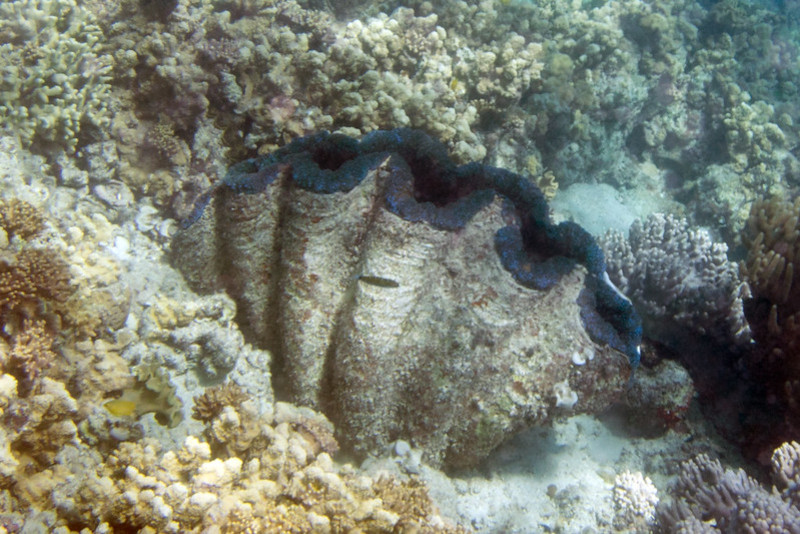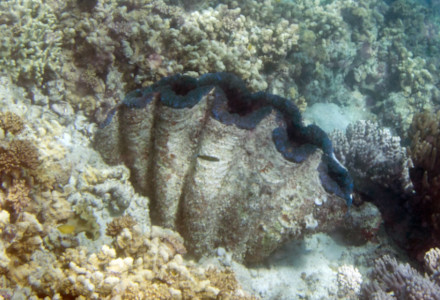
Giant Clam Facts
- The descriptive and appropriate term of Giant Clam serves as the most frequently used common name for this creature. For the moment, though, it has no other broadly accepted general name. Though certainly not unknown, that’s uncommon.
- Intriguingly, however, the name’s applied equally to all 10 members of the genus Tridacna. This understandably often leads to confusion. The title’s most commonly intended for one species, though, and that’s the species referred to in this article.
- Within scientific circles, it’s usually spoken of using its technical name, to avoid confusion. Thankfully for the layperson, that’s a comparatively easy term to pronounce. That’s because this wonder of evolution bears the formal moniker of Tridacna gigas.
- It further received that blessedly simple formal title due to the efforts of Carl Linnaeus. The eminent Swedish zoologist accomplished the first recorded recognition of it as a separate and distinct species. He managed this scientifically noteworthy deed in 1758.
- Unfortunately, however, the populatin numbers of the remarkable Giant Clam appears to be dwindling rapidly. That lamentable situation also seems to hold true throughout the entirety of its range. The IUCN, therefore, now lists the species as Vulnerable.
- The Mollusk now faces multiple threats to its continued existence as a species. Most of these stem from human activities. These include over exploitation of the creature for human consumption. It also faces the peril of habitat loss due to climate change.
Related Articles
Giant Clam Physical Description
The fascinating Giant Clam holds many claims to fame. Its sheer physical size, however, clearly represents its most famous attribute. Nonetheless, many of those fortunate to encounter it also respect the creature for some of its other qualities. Some may surprise you.
Unlike most forms of animal life on the planet, though, the principle of sexual dimorphism doesn’t really apply here. It sidesteps this physiological characteristic in a most unusual manner. That’s yet another manner in which this bivalve merits interest by the observer.
That’s true due to the fact that all individuals of this species are born male! Approximately three years later, those same specimens begin to develop female organs as well. Once the process is complete, at roughly five years of age, it’s a fully functional hermaphrodite.
All specimens therefore present the same general physical appearance. This pertains to both body shape, coloring, and size. Individuals sometimes attain weights of up to 440 lb (200 kg). These same impressive specimens often measure as much as 47 in (1.2 m) in diameter.
Each example of the Giant Clam develops either four or five vertical folds in that incredible shell. The border of its mantle is covered with several hundred eyespots that it uses to see with. Though only 0.02 in (0.5 mm) across, each contains 100 or more photoreceptors.
The outside of the shell varies in color between individuals. It’s also often covered in numerous coral structures, creating random patterns of appearance. The flesh inside, however, presents a dazzling mixture of yellow, green, and blue, and is often iridescent.
- Kingdom: Animalia
- Phylum: Mollusca
- Class: Bivalvia
- Order: Cardiida
- Family: Cardiidae
- Genus: Tridacna
- Species: T. gigas
Giant Clam Distribution, Habitat, and Ecology
The magnificent Giant Clam evolved as native to an area of the globe that’s both expansive and broken. The general area comprising that zone of habitation likely wont surprise many people. That’s because the animal principally lives in the Indian and South Pacific Oceans.
Yet, the creature also appears in the waters around the Philippines, in Asia. Another location in which it lives is in the waters off the Malaysian portion of Borneo, in the South China Sea. Presently, it’s unknown if it ever dwelled anywhere outside this region of habitation.
It’s reasonable to assume that it once lived in regions in between these scattered locations, though. The nature of that situation, however, possibly stems from its decidedly clear preferences in its choice of habitat. That obviously plays a pivotal factor in its location.
The intriguing product of Nature and evolution lives almost exclusively in one of two related types of area. These consist of either regions of broken coral or flat coral sand. It also limits its presence to shallow depths. It’s not known to exist beyond depths of 66 ft (20 m).
Just like its various kindred around the world, the Giant Clam evolved as a filter feeder. It mainly consumes zooplankton and phytoplankton. While it feeds, however, symbiotic algae, provide it with a secondary source of nutrition through their own metabolic processes.
Although hermaphroditic in nature, individuals do not self-fertilize. Durin spawning, each individual releases both sperm and eggs into the water. This then blends with that of others, and the process of live begins. Fertilized eggs sink to the ocean floor after about one week.
Species Sharing Its Range
Check out our other articles on 3 Surprising Sahara Desert Sites, Ribbon Seal, Gobi Desert, Appalachian Avens, Eastern Cicada Killer, Alligator Snapping Turtle, Purple Frog

